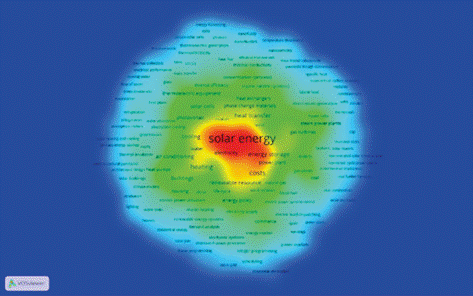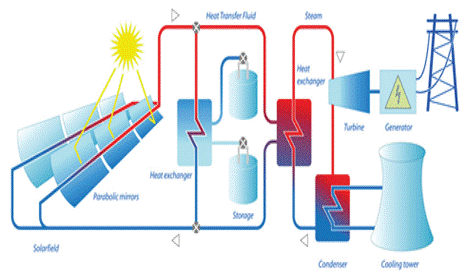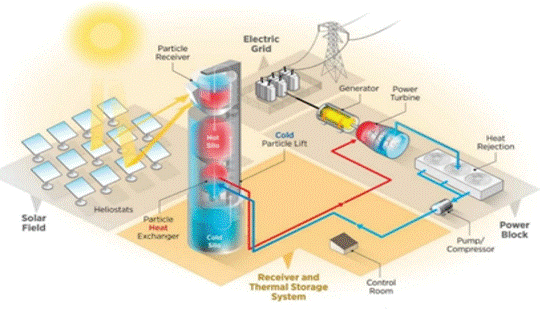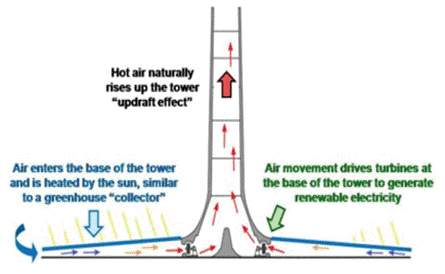1. INTRODUCTION
The electrical energy generated from solar thermal energy can be defined as the result of a process through which the collected solar energy is converted into electricity through the use of some type of device for converting heat into electricity [1-5]. It is mostly a thermal engine, but there are other options, such as solar chimneys with pneumatic turbines [6,7]. Solar thermal electricity did not find its presence in electro-energy networks until the 1980s, although the basic technology for the production of mechanical energy that could be converted to electricity with a conventional generator was available for several decades [8]. The period of the eighties saw the birth of the first thermo-solar installations in order to produce electricity on a large scale [9]. This fact was a response to the challenges of the oil crisis of the 70s. These conditions promoted the improvement and optimization of the most diverse elements of solar capture [10,11].
Solar thermal energy probably has the greatest potential of any other source of renewable energy in the tropics [12], but its development has been delayed due to the resistance of the energy market to large plants and the poor political and financial support of programs of incentives [13-15]. However, at this time there is rapid development in both basic technology and market strategy, and the prospects for rapid growth now seem to be very clear in the global energy context [16,17].
The research problem dealt with in this document is the representation of the most established technologies in the generation of electrical energy in solar thermal installations, and the technological and market trends of this ecological energy proposal. In this document you can find information such as: (i) A bibliometric study that highlights, among other information, the articles most cited by each of the main journals that disseminate research results on Solar thermal electricity. (ii) Bases conceptuales de la generación de electricidad con energía solar térmica. (iii) Most innovative contributions, for each ofthe techniques for generating electricity through solar thermal energy. (iv) Properties of thermal energy storage technologies (TES) in power plants with parabolic solar concentrators or solar concentration towers. Current technologies and trends. (v) Trends in the global energy market.
2. MATERIALS AND METHODS
For the selection and study of the information that allowed the development of this research, the academic directory "Scopus", the "Publish or Perish" softwear and the "VOSviewer (POP)" softwear were used.
Scopus is a bibliographic database of abstracts and citations of scientific articles and journals. This directory covers approximately 18,000 titles from more than 5,000 publishers worldwide, covering 17,000 peer-reviewed journals in the areas of science, technology, social sciences, among others [18]. The Scopus directory, and the information analysis accessories that it provides to its subscribers, allowed the analysis of the performance of the research related to the generation of electricity from solar thermal energy. The "Solar Thermal Electricity" frace was used as a search criterion in the title, abstract and keywords of the research published in Scopus. With the bibliometric analysis tools provided by Scopus, figures 1, 3, 4 and 7 were made.
Publish or Perish is a software program that retrieves and analyzes academic citations. It uses a variety of data sources (incl. Google Scholar and Microsoft Academic Search) to obtain the raw citations, then analyzes these and presents the following metrics: Total number of papers and total number of citations, average citations per paper, citations per author, papers per author, and citations per year, Hirsch's h-index [19] and related parameters, and others. Through this program, the H index of the investigations referred to in tables 1 and 2 was determined.
VOSviewer is a software tool for constructing and visualizing bibliometric networks. These networks may for instance include journals, researchers, or individual publications, and they can be constructed based on citation, bibliographic coupling, co-citation, or co-authorship relations. VOSviewer also offers text mining functionality that can be used to construct and visualize co-occurrence networks of important terms extracted from a body of scientific literature.
From Scopus, the data was imported in CSV format; and it was processed in the VOSviewer software. The information of the detected contributions contained: (i) Title. (ii) Keywords. (iii) Author. (iv) Year of publication. (v) Institution of the authors. (vi) Nationality. (vii) citation index.
VOSviewer was used in text mining and to analyze data from bibliometric networks, collaborative relationships between nations and authors. In addition, it was used to obtain the relation of coincidence between scientific terms under the search criteria previously exposed. With this software figure 2, 5 and 6 were made.
3. RESULTS
From 1960 to the present time, 4,154 articles and 54,922 patents related to the topic dealt with in this work are registered in the Scopus database. Figure 1 shows how the number of publications is distributed. There is a growing interest for scientists and engineers in the electric generation with solar thermal energy in the first five years of this century. Trend that has been increasing [20-23].
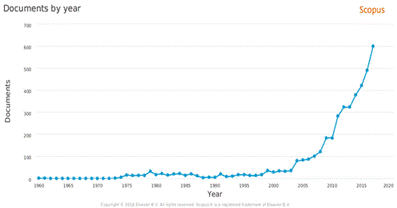
Figure 1 Number of publications or contributions in recent decades. TITLE-ABS-KEY (solar AND thermal AND electricity).
Figure 2 shows a map of scientific terms related to research in the area of electricity generation from solar thermal energy. In this map of terms, the density of the co-occurrence of the term in the contributions is given by the range of colors. Where the red color represents greater density, and its degradation to blue represents less co-occurrence of the term or density of this.
Figure 3 shows how the scientific contributions detected by the different research areas are distributed. Research in energy and engineering are the most proliferating.
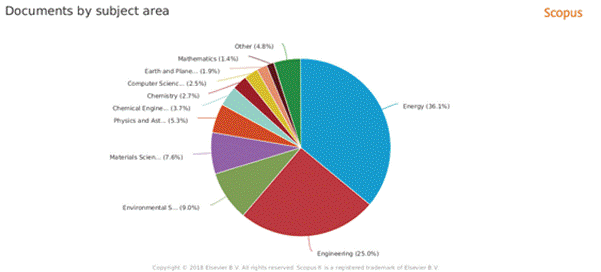
Figure 3 Percentage value of contributions for the different research areas detected in Scopus. TITLE-ABS-KEY (solar AND thermal AND electricity).
The great economic powers worldwide see in the thermo solar generation a financially viable alternative and ecology, in the face of the adversities that the energy market currently presents. This can be corroborated in the information shown in figure 4.
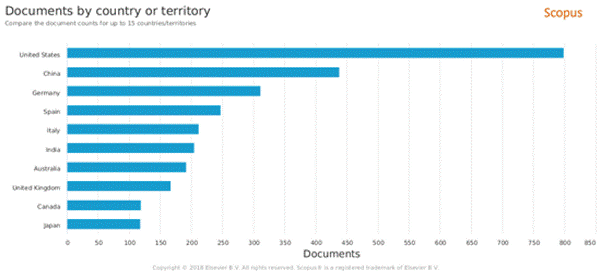
Figure 4 Nations that lead the research in the generation of electric power on a large scale, using solar thermal energy. TITLE-ABS-KEY (solar AND thermal AND electricity)
Figure 5 shows how you relate to the aforementioned nations, in terms of research collaborations and scientific productivity. It is evident that the current economic powers emerge as the epicenter of international scientific collaborations in this field.
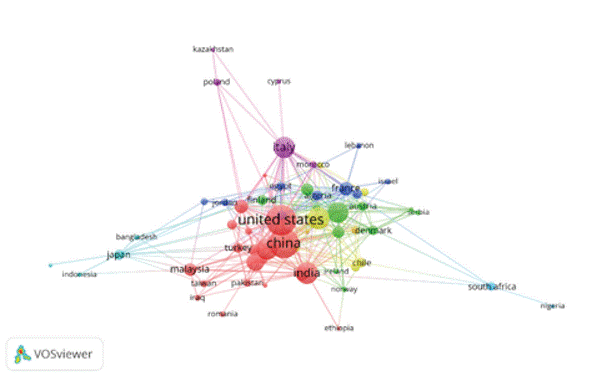
Figure 5 Network of scientific collaboration among nations, referring to the research of electricity generation through solar thermal energy.
The author of greater productivity globally is a member of the Institute of Engineering Thermophysics Chinese Academy of Sciences, Beijing, China. His name is Hongguang Jin, and he has 32 scientific contributions in the academic research catalog Scopus. Said catalog records 3313 citations of the researches of this author. Figure 6 shows the co-authorship network among the most productive authors of the last three years. The range of colors of this graphic allows to locate the researchers in the period of time. The size of the boxes named, establishes the intensity of the scientific production of each author. In the graph you can see that there is a strong correlation between these authors, which justifies that the sizing of these tables is very balanced.
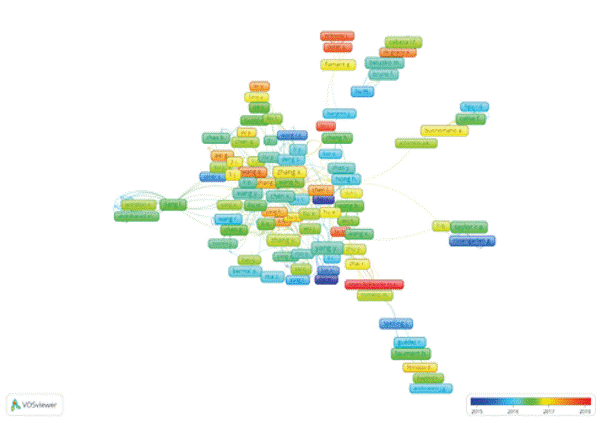
Figure 6 Correlation network among the most productive authors, in this subject within the Scopus directory.
The journals that offer the greatest visibility to research in the area of electricity generation from solar thermal energy are: Energy Proceia, Solar Energy, Renewable Energy, Energy, and Applied Energy. See figure 7.
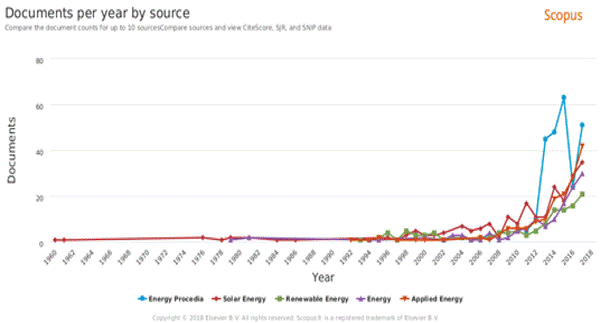
Figure 7 Journals that offer greater socialization worldwide, to the topic addressed. TITLE-ABS-KEY (solar AND thermal AND electricity).
Table 1 shows the contributions most referenced or cited by the international scientific community; for each of the magazine shown in Figure 7. The Hirsch index (h) of each investigation is expressed in the last column of this table. The h index was detected using Publish or Perish software. This tool allowed defining the projection in terms of citations, of each of these articles, not only within the Scopus academic directory, but also in Google Scholar, Science Direct and the Web of Science.
Table 1 Most cited articles by each of the main journals that disseminate this theme.
| Source title | Article title | Authors | Abstract | Keywords | Year | Index H detected | Reference |
|---|---|---|---|---|---|---|---|
| Energy Procedia | A high-efficiency solar thermal power plant using a dense particle suspension as the heat transfer fluid | J. Spelling, A. Gallo, M. Romero, J. González Aguilar | A novel solar power plant concept is presented, based on the use of a dense particle suspension as the heat transfer fluid which allows receiver operation at high temperatures (above 650°C), opening the possibility of using high-efficiency power generation cycles such as supercritical Rankine cycles. A 50 MWe solar power plant was designed based on this new heat transfer fluid and compared with a conventional molten salt solar power plant. The supercritical Rankine-cycle power block increases the termal conversion efficiency from 39.9% to 45.4%, corresponding to a 9.6% reduction in the size of the heliostat field. The operating temperature range is increased by 24.5%, which leads to a 12.5% increase in storage density and a 22.5% reduction in the total storage volume. Parasitic power consumption is also reduced due to the elimination of the need for heat tracing. Overall, the combination of increased cycle efficiency, increased storage density and reduced parasitics to leads to a predicted electricity cost reduction of 10.8% | Dense particle suspensión, supercritical steam-cycle, high efficiency solar power | 2015 | 25 | [25] |
| Solar Energy | Analysis of HTFs, PCMs and fins effects on the thermal performance of shell-tube thermal energy storage units | Zhuo Li, Zhi-Gen Wu | In solar thermal power plant, the thermal energy storage (TES)system is a key component which includes thermal energy storage unit, thermal energy storage material and heat transfer fluid (HTF). We numerically simulate the dynamical thermal performances of shell-tube TES units with diverse geometric configurations, phase change materials (PCMs) including pure NaNO3 and a composite of NaNO3/expanded graphite (EG), and HTFs such as synthetic oil and molten salts. In the charging/discharging process, the conjugated heat transfer behavior between the thermal storage unit and thermal carriage channel is specially concerned. Effects of the extended fin, PCMs and HTFs on improving heat. performance are examined and quantified with total heat flux and effective Nusselt numbers. Together with the presented diagrams of PCM phase evolution, the roles of heat conduction and natural convection in influencing the thermal behavior of the TES units are clearly revealed. The non uniform phase distribution of PCM due to natural convection results in a considerable time spent in the end of the charging/discharging processes. The results show that both the full melting time and solidification time can be shortened at least 14%, benefited from using the extended fins and the composite. This study is expected to provide an apprehensive interpretation of thermal transport mechanism and rational advices in optimizing the TES system operation. | Thermal energy storage Phase change material Heat transfer fluid Enhancing heat transfer | 2015 | 35 | [26] |
| Renewable Energy | Design and Feasibility of high temperature shell and tube latent heat thermal energy storage system for solar thermal power plants | S. Saeed Mostafavi Tehrani, Robert A. Taylor, Pouya Saber, Gonzalo Diarce | A simple shell and tube heat exchanger provide a straightforward design for near-term integration of latent heat thermal energy storage (LHTES) systems in concentrated solar thermal-tower (CST-tower) plants, but currently there is no literature available for this configuration in the 286-565 °C temperature range. Therefore, the primary objective of this work is to evaluate the potential of this configuration for CST-tower plants. In addition, a proper design method of this storage configuration should simultaneously account for the effects of geometric parameters and the number of modules. The present work optimizes these parameters for market ready phase change materials (PCM) that are suitable in the aforementioned temperature range. This optimization consisted of fixing the PCM volume while varying the other geometric parameters (namely, L, L/d, R/ro) simultaneously over a wide range. The goal was to achieve the highest amount of total stored/delivered energy with a minimum heat transfer surface area. This analysis revealed that there was an optimum area between 36 and 63 m2 GJ−1 (or 0.12-0.22 m2 kWhth−1), depending on the PCM employed.This optimum surface area can be obtained with several combinations of geometric parameters, but only certain combinations were found to achieve the highest total stored/delivered energy. The charging and discharging efficiency for the selected PCMs was found to be ~99% and 75-85%, respectively. Using the optimized designs, the cost of this shell and tube LHTES system was found to vary between 27 and 170 US$ kWhth−1, which indicates that with further development it may be competitive with conventional sensible storage systems (e.g. two-tank molten salts). | High temperature-Phase change material Concentrating solar power Parametric analysis Optimization Shell and tube tank | 2017 | 25 | [27] |
| Energy | Optimization of multiple receivers solar power tower systems | E. Carrizosa, C. Domínguez-Bravo, E. Fernández-Cara, M. Quero | In this article a new procedure to optimize the design of a solar power tower system with multiple receivers is presented. The variables related to the receivers (height, aperture tilt angle, azimuth angle and aperture size) as well as the heliostat field layout are optimized seeking to minimize the levelized cost of thermal energy. This is a high dimensional optimization problem with black-box non convex objective function. The proposed strategy alternatively optimizes the receivers and the heliostat field. A separate aiming region is considered for each receiver. The aiming regions, the number of heliostats and their locations are obtained with the proposed procedure. Specifically, heliostat positions are obtained through a pattern free greedy-based location method. | Solar thermal power, Heliostat field layout, Nonconvex optimization, Greedy algorithm, Multiple receivers | 2015 | 14 | [28] |
| Applied Energy | Application of phase change materials for thermal energy storage in concentrated solar thermal power plants: A review to recent developments | Ben Xu, Peiwen Li, Cholik Chan | The objective of this paper is to review the recent technologies of thermal energy storage (TES) using phase change materials (PCM) for various applications, particularly concentrated solar thermal power (CSP) generation systems. Five issues of the technology will be discussed based on a survey to the state-of-the-art development and understandings. The first part is about various phase change materials (PCM) in thermal storage applications and recent development of PCM encapsulation technologies. The second is the current status of research and application of latent heat storage systems in CSP plants. The third is the mathematical modeling and numerical simulations to the phenomenon of latent heat thermal storage. The fourth is about the issues of integration of a PCM-based TES unit into a power generation system and the operation.The last part is a discussion about the cost issues and comparison between sensible and latent heat TES systems. The surveyed information will be very helpful to researchers and engineers in energy storage industry and particularly solar thermal power industry. | Concentrated solar power (CSP), Thermal energy storage (TES), Phase change material (PCM), Latent heat | 2015 | 171 | [29] |
The main result evidenced by this table is that research in thermal accumulation systems represents a fundamental part in the process of optimization and economic competitiveness of electric power generation systems based on solar thermal energy [24].
Conceptuales bases of the generation of electricity with solar thermal energy.
a) Solar thermoelectric system with parabolic troughs.
Thermal solar powered plants that use cylindrical-parabolic cutters use a curved cylindrical mirror to reflect direct solar radiation on a glass tube containing a heat carrier fluid located along the cylinder, positioned at the focal point of these screens reflectors. The variations of the solar position during the day, is followed by tilting the cylinder from East to West, ensuring that the direct radiation remains focused on the sensor [21,30]. The receiver conduit is enclosed in a glass chamber and vacuum. The fluid containing the captured thermal energy is transported to a thermal engine where approximately one third of this energy is transformed into electricity [31]. These systems, due to their thermal accumulation facilities, have the ability to operate with a certain autonomy, in the absence of sunlight. This process is detailed in figure 8.
b) Solar central tower thermoelectric system.
A central tower solar installation, also known as a heliostat power plant, is a type of solar oven that uses a tower to receive concentrated sunlight. For this, it uses a group of flat, mobile mirrors called heliostats, which allow to focus the solar rays in a collector space located in the tower, this area is called the solar oven [32,33].Figure 9 illustrates the described process. The initial designs used these focused rays to heat water and used the resulting steam to drive a turbine. New designs have been obtained using liquid sodium and systems are now in operation that use molten salts as working fluids (40% potassium nitrate, 60% sodium nitrate). These working fluids have a high heat capacity, which can be used to store thermal energy. These heat carriers are responsible for supplying the necessary energy for the water to become the steam used to power the turbines. These designs also allow the generation of electrical energy even in the absence of solar radiation.
c)
c) Solar chimneys.
Solar chimneys represent a technology that combines solar thermal, wind and geothermal technology for electrical generation based on a phenomenon as simple as natural convection [34,35]. The plant consists of a circular surface of land that is covered with a transparent material with a central hollow tower, the air when heated ascends by the chimney moving turbines that are inside [36-38]. A pipeline buried in the ground serves as thermal storage, guaranteeing operation 24 hours a day even without solar radiation. Figure 10 exemplifies this technology.
Table 2 shows the most innovative research in recent years; for each of the techniques for generating electricity from solar thermal energy, discussed above. This criterion is the opinion of the authors of this article, and is based on techniques and materials proposed in these scientific contributions.
Table 2 Most innovative contributions, for each of the techniques for generating electricity through solar thermal energy.
| Article title | Authors | Abstract | Keywords | Year | Reference |
|---|---|---|---|---|---|
| Multi-criteria optimization of an integrated energy system with thermoelectric generator, parabolic trough solar collector and electrolysis for hydrogen production | Habibollahzade A, Gholamian E, Ahmadi P, Behzadi A | In this research paper, a newly energy system consisting of parabolic trough solar collectors (PTSC) field, a thermoelectric generator (TEG), a Rankine cycle and a proton exchange membrane (PEM) is proposed. The integration is performed by establishing a TEG instead of the condenser as power generation and cooling unit thereafter surplus power output of the TEG is transferred to the PEM electrolyzer for hydrogen production. The integrated renewable energy system is comprehensively modeled and influence of the effective parameters is investigated on exergy and economic indicators through the parametric study to better understand the system performance. Engineering equation solver (EES) as a potential engineering tool is used to simulate the system and obtain the desired results. In order to optimize the system, a developed multi-objective genetic algorithm MATLAB code is applied to determine the optimum operating conditions of the system. Obtained results demonstrate that at optimum working condition from exergy viewpoint, exergy efficiency and total cost are 12.76% and 61.69 $/GJ, respectively. Multi-objective optimization results further show that the final optimal point which is well-balanced between exergy efficiency and total cost, has the maximum exergy efficiency of 13.29% and total cost of 63.96 $/GJ, respectively. The corresponding values for exergy efficiency and total cost are 10.01% and 60.21 $/GJ for optimum working condition from economic standpoint. Furthermore, hydrogen production at well-balanced operating condition would be 2.28 kg/h. Eventually, the results indicate that establishing the TEG unit instead of the condenser is a promising method to optimize the performance of the system and reduce total cost. | Multi-objective optimization, PEME, PTSC, Solar collector, TEG, Thermoelectric generator | 2018 | [25] |
| Numerical Modeling of a Two-tower Type Fluidized Receiver for High Temperature Solar Concentration by a Beam-down Reflector System | Matsubara, K. Sakai, H. Kazuma, Y. Sakurai, A. Kodama, T. Gokon, N. Cho, H. S. Yoshida, K. | This study describes the flow and thermal field of a two-tower fluidized receiver, aimed to be incorporated into a beam-down reflector system. An experimental visualization and numerical simulation were made to accumulate phenomenological knowledge, in order to complete the design of a demonstration model. Visualization of the cold particle bed with no irradiation revealed that global circulation occurs between the two towers by the aeration with different line velocities. The numerical simulation revealed that this global circulation enhances the transport of sensible heat from the irradiated layer in the high pressure tower to the low pressure tower. The global circulation in the two-tower fluidized receiver has the potential to be extended for use in a thermal receiver and direct storage system. Unexpectedly, local circulations occur on the high and low pressure sides, and are stronger than the global circulation. These local circulations contribute to the thermal mixing in each tower. The bottom distributor on the low pressure side can cause an uprising flow which leads to the local circulation. The design of the distributor is suggested to be elaborated based on these finding | Beam-down reflector system Fluidized bed Numerical simulation Solar receiver Computer simulation Fluidization Numerical models Reflection Solar energy Towers Cold particles Global circulation High temperature Low pressures Reflector system Solar concentration Thermal mixing Fluidized beds | 2015 | [39] |
| Mathematical evaluation of solar chimney power plant collector, integrated with external heat source for non interrupted power generation | Aurybi, M. A. Gilani, S. I. Al-Kayiem, H. H.Ismaeel, A. A. | One of the largest challenges in the use of solar energy for power generation is the interruption at night and during cloudy weather. This study proposed a new technique of integrating the solar chimney power plant with an external heat source. The integration can be achieved by installing “Thermal Enhancing Channels” inside the collector region between the canopy and the ground to enhance the kinetic energy of the air inside the collector, eventually allowing the plant to operate at night. The thermo-fluid dynamics of the proposed hybrid system were modeled mathematically to evaluate the performance of the proposed model. The analysis gave a good propaedeutic overview of solar chimney power plant integrated with an external heat source. The results showed that the temperature of the air inside the collector could be increased by the addition of thermal enhancing channels within the collector of the solar chimney. The increasing percentage of the temperature for the air inside the collector reached to 5.88% and for power generation 23.1% when the wall temperature of thermal enhancing channels is100°C and solar intensity 1000 W/m2. | Energy recovery Hybrid energy system Integrated solar collector Solar chimney power plant Thermal enhancement channels Chimneys Hybrid systems Integration Kinetic energy Kinetics Solar energy Integrated solar collectors Thermal enhancement Solar chimneys | 2018 | [40] |













